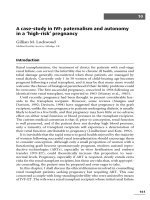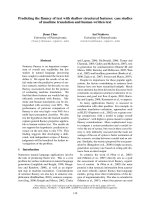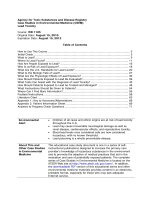Ebook Case studies in child, adolescent , and family treatment (2/E): Part 1
Bạn đang xem bản rút gọn của tài liệu. Xem và tải ngay bản đầy đủ của tài liệu tại đây (2.61 MB, 211 trang )
Case Studies in
Child, Adolescent,
and Family Treatment
Craig Winston LeCroy and Elizabeth K. Anthony
editors
Case Studies in
Child, Adolescent,
and Family Treatment
Second
Edition
Cover design: Wiley
Cover image: © Shutterstock.com/LFor
This book is printed on acid-free paper.
Copyright © 2015 by John Wiley & Sons, Inc. All rights reserved.
Published by John Wiley & Sons, Inc., Hoboken, New Jersey.
Published simultaneously in Canada.
No part of this publication may be reproduced, stored in a retrieval system, or transmitted in any form
or by any means, electronic, mechanical, photocopying, recording, scanning, or otherwise, except as
permitted under Section 107 or 108 of the 1976 United States Copyright Act, without either the prior
written permission of the Publisher, or authorization through payment of the appropriate per-copy fee to the
Copyright Clearance Center, Inc., 222 Rosewood Drive, Danvers, MA 01923, (978) 750-8400, fax (978)
646-8600, or on the web at www.copyright.com. Requests to the Publisher for permission should be
addressed to the Permissions Department, John Wiley & Sons, Inc., 111 River Street, Hoboken, NJ 07030,
(201) 748-6011, fax (201) 748-6008.
Limit of Liability/Disclaimer of Warranty: While the publisher and author have used their best efforts in
preparing this book, they make no representations or warranties with respect to the accuracy or completeness
of the contents of this book and specifically disclaim any implied warranties of merchantability or fitness for a
particular purpose. No warranty may be created or extended by sales representatives or written sales materials.
The advice and strategies contained herein may not be suitable for your situation. You should consult with
a professional where appropriate. Neither the publisher nor author shall be liable for any loss of profit or any
other commercial damages, including but not limited to special, incidental, consequential, or other damages.
This publication is designed to provide accurate and authoritative information in regard to the subject
matter covered. It is sold with the understanding that the publisher is not engaged in rendering professional
services. If legal, accounting, medical, psychological or any other expert assistance is required, the services of
a competent professional person should be sought.
Designations used by companies to distinguish their products are often claimed as trademarks. In all
instances where John Wiley & Sons, Inc. is aware of a claim, the product names appear in initial capital
or all capital letters. Readers, however, should contact the appropriate companies for more complete
information regarding trademarks and registration.
For general information on our other products and services please contact our Customer Care Department
within the United States at (800) 762-2974, outside the United States at (317) 572-3993 or fax (317) 572-4002.
Wiley publishes in a variety of print and electronic formats and by print-on-demand. Some material
included with standard print versions of this book may not be included in e-books or in print-on-demand. If
this book refers to media such as a CD or DVD that is not included in the version you purchased, you may
download this material at . For more information about Wiley products, visit
www.wiley.com.
Library of Congress Cataloging-in-Publication Data:
LeCroy, Craig W.
Case studies in child, adolescent, and family treatment / Craig Winston LeCroy, Elizabeth K. Anthony.—
Second edition.
1 online resource.
ISBN 978-1-118-12835-0 (pbk) ISBN 978-1-118-41897-0 (epdf ) ISBN 978-1-118-41644-0 (epub)
1. Child psychotherapy—Case studies. 2. Adolescent psychotherapy—Case studies. 3. Family
psychotherapy—Case studies. I. Anthony, Elizabeth K. II. Title.
RJ504.L43 2015
618.92′8914—dc23
2014017654
Printed in the United States of America
10 9 8 7 6 5 4 3 2 1
Contents
EPAS standards
ix
Matrix for chapter content
Preface
xvii
1
xiii
Case Studies in Individual Treatment and Assessment
Case Study 1‐1 From Childhood to Young Adulthood with
ADHD
Susan Bogas
Case Study 1‐2 Solution‐Focused Therapy with Child
Behavior Problems
Jacqueline Corcoran
Case Study 1‐3 Crisis Intervention with a Depressed
African American Adolescent
Jewelle Taylor Gibbs
Case Study 1‐4 What a Few CBT Sessions Can Do:
The Case of a Motivated Young Adult
Kathy Crowley
Case Study 1‐5 The Case of Aundria: Treating Substance
Abuse During Adolescence Using CBT and
Motivational Interviewing
Paul Sacco
Charlotte Lyn Bright
Janai Springer
v
1
5
29
45
64
72
vii CONTENTS
Case Study 1‐6 A Developmental Approach to
Working with Sexually Abusive Youth
George Stuart Leibowitz
Susan L. Robinson
Case Study 1‐7 Effective Interventions for Adolescent
Conduct Disorder in Residential Treatment
Jamie L. Glick
2
3
86
110
Case Studies in Group Treatment
130
Case Study 2‐1 A Social Skills Group for Children
Craig Winston LeCroy
Case Study 2‐2 A Culturally Grounded Empowerment
Group for Mexican American Girls
Lori K. Holleran Steiker
Eden Hernandez Robles
Case Study 2‐3 Developmental Play Groups with
Kindergartners in a School Social Work Setting
Timothy A. Musty
Case Study 2‐4 Gay Youth and Safe Spaces
Nora Gustavsson
Ann MacEachron
133
Case Studies in Family Treatment and
Parent Training
Case Study 3‐1 HOMEBUILDERS®: Helping Families
Stay Together
Nancy Wells Gladow
Peter J. Pecora
Charlotte Booth
Case Study 3‐2 Evidence‐Based Approach to
Parent Training
Randy Magen
Case Study 3‐3 Promoting Positive Parenting:
Infant Mental Health Intervention with
High‐Risk Families
Brenda Jones Harden
Elena Aguilar
Cindy Cruz
Elizabeth Aparicio
145
162
174
182
184
203
219
Contents
4
Case Studies in Child Welfare and Adoption
Case Study 4‐1 A Case Study of the Application of
NTU Psychotherapy for Treatment Foster Care and
Emotional Trauma
Frederick B. Phillips
Peter Fitts
Case Study 4‐2 Helping Families with Reunification:
Returning a Child to a Less‐Than‐Perfect Family
Lindsay Bicknell-Hentges
John Lynch
Case Study 4‐3 Nothing Left to Lose:
Growing Up in Foster Care
Debbie Hunt
Case Study 4‐4 Deciding What Is Best for Savannah:
The Grief and Joy in a Successful Adoption
Melissa Evans
5
Case Studies in School and Community Settings
Case Study 5‐1 Zai: A Hmong Adolescent Creates
His Own Way
Harriet Cobb
A. Renee Staton
Krystal Studivant
Case Study 5‐2 Understanding Bullying and Peer
Victimization: The Important Roles of Peers, Parents,
and School Personnel in Prevention and Intervention
Anne Williford
Case Study 5‐3 Finding a Voice and Making It Heard:
A Case Study of Low‐Income Urban Youth
Nicole Nicotera
Case Study 5‐4 Living in Survival Mode:
A Young Woman’s Experience of Homelessness
Richard Geasland
Rachelle Wayne
Author Index 363
Subject Index 371
vii
236
239
263
277
289
296
299
312
328
346
EPAS Standards
The Council on Social Work Education’s Educational Policy and Accreditation
Standards for 2015 has set forth recommendations for students of social work
to master nine competencies. Within each competency are practice behaviors
that further define the core competencies. Case Studies in Child, Adolescent, and
Family Treatment, 2nd Edition addresses the nine competencies within the various case studies presented in the book. The following table lists the EPAS competencies and the case studies that most directly reflect the competency. This
may be helpful to both instructors and students as they relate the educational
material in the book to the core competencies for effective social work practice.
Competency 1 Ethical and Professional Behavior
1-4
Providing brief treatment when indicated
1-3; 1-5; 5-4 Professional self-awareness
1-5; 3-3
Balancing various professional roles
1-6
Staying current on developments in a rapidly changing field
4-4
Staying objective in a complex intervention environment
5-1
Recognizing the need for more information to ethically
treat a client system
Competency 2 Diversity and Difference
1-3
Engaging with the client’s culture in treatment
2-2
Culturally grounded empowerment
2-4
Engaging peer support with sexual minority youth
ix
x EPAS STANDARDS
3-1
4-1
4-2
5-1
5-4
Treatment with single father and son
Infusing cultural intelligence into treatment
Recognizing and respecting different parenting
Addressing the cross-cultural nature of the therapeutic
relationship
Understanding the culture of street-dependent youth
homelessness
Competency 3 Social Justice and Human Rights
2-4
Advocating for equal rights for LGBT youth
4-1
Changing systems
5-2
Prevention of victimization by bullying and other forms
of aggression
5-3
Youth advocacy for low-income neighborhood reform
Competency 4 Practice-Informed Research and Research-Informed Practice
2-3
Using research in practice
3-2
Consulting empirically tested models in the design of a
parent program; using client feedback to inform treatment
3-3
Integrating infant mental health principles into an existing primary prevention program
5-1
Applying evidence-based, culturally sensitive treatment
modalities
Competency 5 Policy Practice
2-4
Narrow and discriminatory policies
4-1
Working within system constraints
5-2
School-level bullying policy
5-3
Challenging negative beliefs about low-income youth
5-4
Limited services for homeless youth
Competency 6 Engagement
1-2
Parent and child together in session
1-5
Court-mandated treatment
1-7
Difficult to engage client
4-3
Engaging client systems
1-3; 5-1
Therapeutic alliance, evaluating suicidality
EPAS Standards
Competency 7 Assessment
1-1
Changing therapeutic strategy as the needs of the individual client system change
1-7
Prioritizing treatment strategies based on client process
and professional judgment
2-3
Using knowledge of child development to design treatment
3-2
Stages of group process
4-2
Sequencing goals in family treatment
Competency 8 Intervention
2-1
Social skills group with children; treatment in the natural environment
2-4
Facilitating group work
3-1
Using theory-based treatments
3-3
Treatment focused on the caregiver–infant dyad
4-1
Developmentally appropriate treatment for adolescents
5-2
School-level intervention/prevention
5-3
Neighborhood-level intervention
1-1; 1-2; 1-4; 2-2; 3-3; 5-3 Strengths approach
Competency 9 Evaluation
1-5
Use of standardized assessment measures
2-3
Pre-test/post-test design in treatment
4-3
Self-reflection; understanding role within other systems of
professionals
xi
Matrix for Chapter Content
Topic Area: Advanced Treatment Methods
1-1; 3-3
Effective use of a treatment team
1-2; 5-1
Solution-focused therapy
1-3
Crisis intervention
1-4; 1-5; 1-6; 1-7; 5-1 Cognitive-behavioral therapy
1-5, 1-7
Motivational Interviewing
1-6
Multiple modalities; trauma-informed therapy; psychosexual assessment
1-7, 4-2
Counseling within residential programming
2-3
Theraplay
3-1
Intensive, home-based family preservation
3-1
Rational-emotive therapy
3-3
Attachment and Biobehavioral Catch-Up (ABC)
4-1
NTU Psychotherapy
5-1
Integrative psychotherapy
Topic Area: Advocacy
2-2
Cultural connection and support for marginalized populations
2-4
Environmental manipulation and support for gay youth
4-1
Advocating for child in legal guardianship transitions
5-2
Preventing victimization
xiii
xivv MATRIX FOR CHAPTER CONTENT
5-3
5-4
Community organizing with low-income youth
Positive youth development with homeless youth
Topic Area: Mental Health Disorders
1-1
ADHD
1-3
Depression
1-5; 4-1
Substance abuse
1-6
Co-occurring PTSD and ADHD
1-7
Conduct disorder
Topic Area: Child Welfare Involvement
1-6
Group home
3-2
At risk for child maltreatment
4-1
Therapeutic foster care/specialized foster care
4-2
Reunification
4-3
Foster care
3-1; 3-3; 4-4 Preventing possible child welfare involvement
Topic Area: Juvenile Justice Involvement
1-5
Marijuana charges
1-6
Sexual offending, animal cruelty, destruction of property, stealing, fire-setting, aggression
4-1
Shoplifting
4-3
Dually adjudicated (dependent and delinquent)
Topic Area: Families
1-1
Family involvement in treatment
1-2
Parent involvement in youth treatment
1-5
Multigenerational substance use
3-1
Family preservation
3-2; 3-3
Parent training and education
3-3
Intimate partner violence and family processes
4-1
Working with sibling group as the family unit
4-2
Challenging family dynamics in family therapy
Topic Area: Diversity
2-2
Mexican American girls’ empowerment group
Matrix for Chapter Content
2-4
3-3
4-1
5-1
5-3
Group work with gay youth
Immigrant Latino family
Afrocentric approach to treatment
Understanding the culture of a Hmong adolescent
Working with low-income youth living in public housing
Topic Area: Ecological Model/Generalist Practice
2-1;2-3
Promoting competence in children
2-3
Preventive group counseling in school setting
2-4
Treatment of systems
4-3
Systems of care; wraparound services
5-2
Prevention
5-3
Capacity building for prevention
5-3; 5-4
Positive youth development
xv
Preface
This book relies on a successful formula for teaching students about clinical
practice—the case study method. This method provides a different format
to learn about social work practice than is currently available in traditional
social work textbooks. Our intent was to provide an educational experience
that emerges from reading and thinking about case studies. The case study
method became well known because of its use as a primary teaching method
in schools of business, in particular, its use in the Harvard Business School.
In social work, case studies can be used as action-oriented educational tools
that essentially help students “participate” in the process of doing social
work. This book builds on an earlier effort, Case Studies in Social Work Practicee, which focused on social work generally. We thought it would be equally
valuable to create a case study book that was focused on child, adolescent,
and family practice.
This book can be used as a primary or secondary textbook for direct
practice courses in social work. Because the case study method builds on the
theory of social work practice presented in most textbooks, this book can
be used in foundation and advanced courses. In particular, the book would
be a good fit for courses on social work practice with children, adolescents,
and families. Also, many instructors have used this book to complement
field seminars where there is more focus on the practical aspects of doing
social work. Lastly, because the book includes a diverse range of case studies,
this book can be used to present an overview of practice content with
children, adolescents, and families. For example, this book has been used
xvii
xviiii PREFACE
as a supplement to a Human Behavior and Social Environment course to
integrate the more theoretical content of that class with the practical application of social work principles across the first part of the life course. Because
the case study method can be used in many creative ways, we hope this book
finds broad application in the social work and human services curriculum.
TO THE INSTRUCTOR (AND STUDENT)
The purpose of this book is to help students learn clinical practice by studying how practitioners have applied clinical principles to particular real-world
case situations. In order to facilitate learning, each case study begins with a
set of questions. These questions are designed to help students engage
with the material, to stimulate critical thinking, and to promote classroom
discussion.
As students read these case studies, they can be encouraged to think about
the cases as if they were practitioners. How would you feel if confronted with
this case? What stands out as important in this case to you and why? Do you
agree with the approach taken by the practitioner? What alternative methods
would you consider with this case? Classroom discussions can investigate the
judgments made by the clinicians and discuss what is considered good or bad
about the approach taken in each case. Other suggestions about how the case
studies can be used in a course include the following:
◆
◆
◆
◆
Have students think about what they might have done differently and
why.
Have students write out a treatment plan based on the case.
Have students describe and analyze policies, organizational factors,
and ethical issues inherent in the case studies.
Conduct role-plays in which students act out the roles of the practitioners and clients in each case.
Our hope is that students and instructors can use these case studies to
stimulate critical, analytical, and objective thinking about clinical practice.
As a case is discussed, several perspectives are likely to emerge. Within this
context, underlying assumptions about human behavior and clinical practice
can be brought out in a discussion. Most importantly, the interaction and
exchange of ideas can promote an atmosphere of critical discussion. Clinical
Preface
xix
case presentations are frequently accepted without critique and analysis,
limiting the learning that can occur. We hope that as students and instructors move from case to case, they will begin to develop an accumulation of
experience in thinking and reasoning as applied to the different case material
presented, resulting in more effective clinical practice.
THE SECOND EDITION
It is very exciting to have a second edition of the Case Studies in Child, Adolescent, and Family Treatmentt! The overall organization of the text remains
similar to the first edition. The major changes include updating the case
material and adding new cases. In particular, new material has been added
that reflects newer changes in the field. For example, case studies have been
added in areas such as CBT for youth, adolescent substance abuse, treatment
for conduct disorder in a residential setting, developmental play groups,
facilitating a successful adoption, and prevention and intervention for bullying and peer victimization.
This edition includes case study material in five separate sections that
include case studies in individual treatment and assessment group treatment,
family treatment and parent training, child welfare and adoption, and school
and community settings. Also included are an EPAS crosswalk, which shows
how the material meets the Council on Social Work Education (CSWE)
competency standards, and a matrix for chapter content that shows the different concepts covered by the cases. This information will be particularly
useful for instructors who want to use only specific case studies to cover their
course content. For example, an instructor teaching foundations of social
work practice might want to use the case studies that present an ecological
framework.
ACKNOWLEDGMENTS
This book would not exist without the many authors who graciously agreed
to contribute a case study. We appreciate their efforts and their patience
throughout the process. Although many individuals contribute to the successful publication of a book, we would like to particularly thank Rachel
Livsey, senior editor, and Amanda Orenstein, editorial assistant—this team
provided valuable support throughout the process.
About the Editors
CRAIG WINSTON LECROY
Y is a professor in the School of Social Work
at Arizona State University. He also holds appointments at the University of
Arizona in the John & Doris Norton School of Family and Consumer
Sciences, Family Studies and Human Development division, and at the
University of Arizona College of Medicine, Department of Pediatrics. He has
been a visiting professor at the University of Canterbury, New Zealand; the
Zellerbach Visiting Professor at the University of California at Berkeley; and
a senior Fulbright specialist.
Professor LeCroy has published 10 books previously, including Parenting
Mentally Ill Children: Faith, Hope, Support, and Surviving the System; First
Person Accounts of Mental Illness and Recovery; Handbook of Evidence-Based
Treatment Manuals for Children and Adolescents; Handbook of Prevention and
Intervention Program for Adolescent Girls; The Call to Social Work: Life Stories,
Case Studies in Social Work Practice; Empowering Adolescent Girls: Examining
the Present and Building Skills for the Future with the “Go Grrrls” Program; Go
Grrrls Workbook; Human Behavior and the Social Environment; and Social
Skills Training for Children and Adolescents.
Professor LeCroy has published more than 100 articles and book chapters
on a wide range of topics, including mental health, the social work profession, home visitation, and research methodology. He is the recipient of
numerous grants, including (as principal investigator or co-principal investigator) interventions for risk reduction and avoidance in youth (NIH), Go
Grrrls Teen Pregnancy Prevention Program, evaluation of Healthy Families
xxi
xxiii ABOUT THE EDITORS
(a child abuse prevention program), a mental health training grant for improving service delivery to severely emotionally disturbed children and adolescents (NIMH), and Youth Plus: Positive Socialization for Youth (CSAP).
Y is an associate professor in the School of
ELIZABETH K. ANTHONY
Social Work at Arizona State University, where she teaches advanced clinical
practice with children and adolescents and practice-oriented research. She is
also a Faculty Affiliate of the Southwest Interdisciplinary Research Center.
Her scholarship focuses on resilience among children and youth living in
urban poverty and the prevention of risk behaviors and mental health conditions among ethnically and culturally diverse adolescents. She has published
more than 30 peer-reviewed articles, books, and book chapters on these topics. Dr. Anthony’s current study in multiple public housing neighborhoods
supports the design of contextual-developmental interventions to increase
positive adaptation among adolescents who are exposed to considerable risk
and stress. Dr. Anthony is also an author of Risk, Resilience, and Positive
Youth Development: Developing Effective Community Programs for At-Risk
Youth. Lessons from the Denver Bridge Project.
Contributors
Elizabeth Aparicio, PhD
School of Social Work
University of Hawaii
Hilo, HI
Lindsay Bicknell-Hentges, PhD
Professor of Psychology and Counseling
Chicago State University
Chicago, IL
Susan Bogas, PhD
Psychologist, Private Practice
Princeton, NJ
Charlotte Booth, MSW
Executive Director
Institute for Family Development
Federal Way, WA
Charlotte Bright, PhD
Associate Professor
School of Social Work
University of Maryland
Baltimore, MD
xxiii









